
Georgetown is a historic neighborhood and commercial and entertainment district located in Northwest Washington, D.C., situated along the Potomac River. Founded in 1751 in the Province of Maryland, the port of Georgetown predated the establishment of the federal district and the City of Washington by 40 years. Georgetown remained a separate municipality until 1871 when the United States Congress created a new consolidated government for the whole District of Columbia. A separate act, passed in 1895, specifically repealed Georgetown's remaining local ordinances and renamed Georgetown's streets to conform with those in the City of Washington.

The Washington Navy Yard (WNY) is the former shipyard and ordnance plant of the United States Navy in Southeast Washington, D.C. It is the oldest shore establishment of the U.S. Navy.
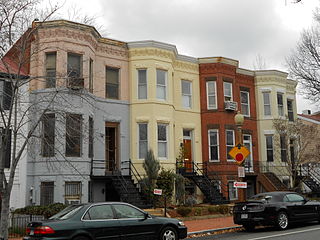
Capitol Hill, in addition to being a metonym for the United States Congress, is the largest historic residential neighborhood in Washington, D.C., stretching easterly in front of the United States Capitol along wide avenues. It is one of the oldest residential neighborhoods in Washington, D.C., and, with roughly 35,000 people in just under 2 square miles (5 km2), it is also one of the most densely populated.
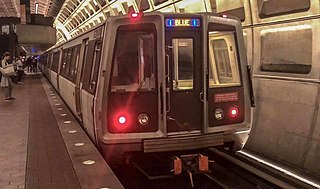
The Blue Line is a rapid transit line of the Washington Metro system, consisting of 27 stations in Fairfax County, Alexandria and Arlington, Virginia; the District of Columbia; and Prince George's County, Maryland, United States. The Blue Line runs from Franconia–Springfield to Largo Town Center. The line shares tracks with the Orange Line for 13 stations, the Silver Line for 18, and the Yellow Line for six. Only three stations are exclusive to the Blue Line.
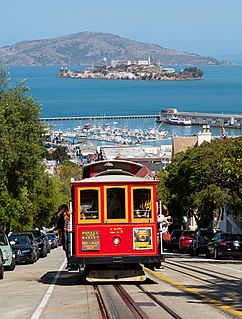
The San Francisco cable car system is the world's last manually operated cable car system and an icon of the city of San Francisco. The system forms part of the intermodal urban transport network operated by the San Francisco Municipal Railway, which also includes the separate E Embarcadero and F Market & Wharves heritage streetcar lines, and the Muni Metro modern light rail system. Of the 23 cable car lines established between 1873 and 1890, only three remain : two routes from downtown near Union Square to Fisherman's Wharf, and a third route along California Street. While the cable cars are used to a certain extent by commuters, the vast majority of the millions of passengers who use the system every year are tourists, and as a result, the wait to get on can often reach two hours or more. They are among the most significant tourist attractions in the city, along with Alcatraz Island, the Golden Gate Bridge, and Fisherman's Wharf. San Francisco's cable cars are listed on the National Register of Historic Places and are designated as a National Historic Landmark.

The Burning of Washington was a British invasion of Washington City, the capital of the United States, during the Chesapeake Campaign of the War of 1812. It is the only time since the American Revolutionary War that a foreign power has captured and occupied the capital of the United States.

The history of Washington, D.C., is tied to its role as the capital of the United States. Originally inhabited by an Algonquian-speaking people known as the Nacotchtank, the site of the District of Columbia along the Potomac River was first selected by President George Washington. The city came under attack during the War of 1812 in an episode known as the Burning of Washington. Upon the government's return to the capital, it had to manage the reconstruction of numerous public buildings, including the White House and the United States Capitol. The McMillan Plan of 1901 helped restore and beautify the downtown core area, including establishing the National Mall, along with numerous monuments and museums.
National Community Church (NCC) is a multi-site church located in the Washington, D.C. area, pastored by Mark Batterson. The vision of the church is to meet in movie theaters at metro stops all across the Washington DC area. Weekly sermons are also available online as audio and video podcasts and on-demand webcasts.

Streetcars in Washington, D.C. transported people across the city and region from 1862 until 1962.

Pittsburgh Railways was one of the predecessors of the Port Authority of Allegheny County. It had 666 PCC cars, the third largest fleet in North America. It had 68 streetcar routes, of which only three are used by the Port Authority as light rail routes. With the Port Authority's Transit Development Plan, many route names will be changed to its original, such as the 41D Brookline becoming the 39 Brookline. Many of the streetcar routes have been remembered in the route names of many Port Authority buses.

Navy Yard, also known as Near Southeast, is a neighborhood on the Anacostia River in Southeast Washington, D.C. Navy Yard is bounded by Interstate 695 to the north and east, South Capitol Street to the west, and the Anacostia River to the south. Approximately half of its area is occupied by the Washington Navy Yard, which gives the neighborhood its name. The neighborhood is located in D.C.'s Ward 6, currently represented by Charles Allen. It is served by the Navy Yard – Ballpark Metro station on the Green Line.
The Capital Traction Company was the smaller of the two major street railway companies in Washington, D.C., in the early 20th century. It was formed in 1985 through a merger of the Rock Creek Railway and the Washington and Georgetown Railroad Company. The company's streetcars connected the Washington, D.C., neighborhoods of Georgetown, Capitol Hill, the Armory, and Mount Pleasant; and the suburb of Chevy Chase, Maryland. In 1933, it merged with its major competitor, the Washington Railway and Electric Company, to form the Capital Transit Company.
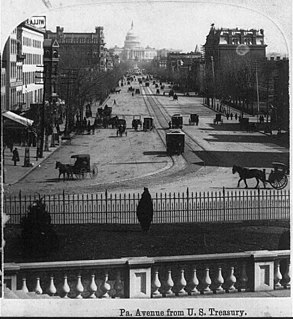
The Washington and Georgetown Railroad Company was the first streetcar company to operate in Washington, D.C. It was incorporated and started operations in 1862, using horse-drawn cars on tracks between Georgetown and the Navy Yard. Two additional lines ran on 7th Street NW/SW and 14th Street NW. In 1890, it switched to cable cars. On September 21, 1895, the company was purchased by the Rock Creek Railway and the two formed the Capital Traction Company.

The Pennsylvania Avenue Line, designated Routes 32, 34, and 36, is a daily Metrobus route in Washington, D.C., Operating between the Southern Avenue station or Naylor Road station of the Green Line of the Washington Metro and the Archives station of the Green and Yellow Lines of the Washington Metro or Potomac Park. Until the 1960s, it was a streetcar line, opened in 1862 by the Washington and Georgetown Railroad as the first line in the city.
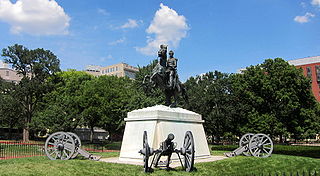
The Lafayette Square Historic District is a National Historic Landmark District in Washington, D.C., encompassing a portion of the original L'Enfant Plan for the city's core. It includes the 7-acre (2.8 ha) Lafayette Square portion of President's Park, all of the buildings facing it except the White House, and the buildings flanking the White House to the east and west. The district was designated a National Historic Landmark in 1970.

The Metropolitan Railroad was the second streetcar company to operate in Washington, D.C., United States. It was incorporated and started operations in 1864, running from the Capitol to the War Department and along H Street NW in downtown. It added lines on 9th Street NW, on 4th Street SW/SE, along Connecticut Avenue to Dupont Circle, to Georgetown, to Mt. Pleasant and north along Georgia Avenue. In the late 19th Century it was purchased by the Washington Traction and Electric Company and on February 4, 1902, became a part of the Washington Railway and Electric Company.
The Steam Railroading Institute is located at 405 South Washington Street, Owosso, Michigan. It was founded in 1969 as the Michigan State University (MSU) Railroad Club. It became the Michigan State Trust for Railway Preservation, and later adopted its present name.
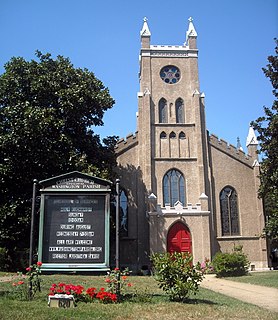
Christ Church — known also as Christ Church, Washington Parish or Christ Church on Capitol Hill — is a historic Episcopal church located at 620 G Street SE in Washington, D.C., USA. The church is also called Christ Church, Navy Yard, because of its proximity to the Washington Navy Yard and the U.S. Marine Barracks nearby.
Madison Marquette Real Estate Services is a Washington D.C.-based investor, developer and operator of mixed-use real estate. Madison Marquette provides investment management, development, leasing and property services to a diverse portfolio of 330 assets in 20 states and manages an investment portfolio valued at over $6 billion.

The Georgetown Car Barn, historically known as the Capital Traction Company Union Station, is a building in the Georgetown neighborhood of Washington, D.C., in the United States. Designed by the architect Waddy Butler Wood, it was built between 1895 and 1897 by the Capital Traction Company as a union terminal for several Washington and Virginia streetcar lines. The adjacent Exorcist steps, later named after their appearance in William Friedkin's 1973 horror film The Exorcist, were built during the initial construction to connect M Street with Prospect Street.



















